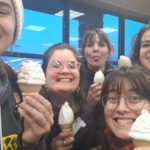This post is written by Colleen Sanders who is serving with the National Center for Appropriate Technology in Butte, MT.
Martin Luther King Day is a big deal for AmeriCorps volunteers. All across the state, dedicated members go out into their communities and make a positive impact, helping to change their little corner of the globe for the better. Here in Butte, we Montana Energy Corps volunteers honored Dr. King’s legacy by improving the energy efficiency of low income homes, to help residents save money and to conserve water and natural resources for all of Montana. Energy Corps members scattered throughout the state traveled to Butte to make this event a success, and we wouldn’t have made the impact we did without the knowledge and volunteer-power from Professor John Jackam and his amazing students from Highlands Technical College, who came out and freely gave their time and effort to our project. The setup was pretty simple: we had two groups of buildings, the Elm Street Apartments and the Rosalie Manor, both owned and operated by the Public Housing Authority of Butte, the residents of which were mostly low-income families and seniors over 60. We were of one mind and had one goal: to weatherize!
Elm Street consisted of 35 one-, two-, and three-bedroom apartments, divided into 14 single-story duplexes, all connected by a network of green spaces, though “white spaces” would be a more appropriate term for Butte in January. The day may have been clear and sunny, but the snow remained ankle-deep, encouraged to outstay its welcome by weeks of below-freezing temperatures. It made a satisfying crunch as our groups trudged through it to get to the maintenance rooms at the back of the apartments. The residents of Elm Street all shared a water heater and tank per duplex and we had made it our mission to increase each building’s energy efficiency by wrapping the water tanks with fiberglass insulation and covering the hot water pipes with high-density foam to prevent heat loss to the elements. We had split up into 4 separate groups, with each group having 2 Energy Corps members and 1-2 volunteers from Highlands College, and fanned out amongst the housing honeycomb to work our weatherizing magic.

Our group quickly decided that we were the “A-Team” and started referring to ourselves thusly, with EC members myself and Angie paired with Highlands students John and Adam, trading off tasks — usually based on the height requirement that each demanded. Our work was speedy and efficient; we hustled from room to room in a blaze of batting and duct tape, assessing the needs of each separate set-up and insulating accordingly. Slowed only briefly by shortage of electrical tape – solved by EC member Anthony (and Professor Jackam’s trusty credit card) – our group alone had gotten 4 water tanks and their web of piping insulated and set to save money by the time lunch had arrived.
After lunch, it was time for Weatherization Round 2: Enter Rosalie Manor. Across town from Elm Street, the Rosalie Manor was a single apartment complex, with 4 floors and 66 units, most of which needed to have inefficient showerheads and faucet aerators replaced with new, low-flow versions, which is where our small army came in. Led by Mike Lyons and his trusty crew of maintenance men, we started at the top floor and worked our way down, moving en masse like a swarm of energy efficiency locust through the narrow hallways. Not every door that was knocked on was receptive to our mission, but the tenants had been warned in advance of our intentions and most were either mildly interested or politely ignored us as we went about replacing their fixtures and switching out incandescent bulbs for new CFL’s. By the time we had finished with the ground floor, we had completed two days worth of work in less than one day. High-fives were had all around.

The next day we held the educational component of our event, a presentation and game, open to the Butte community, that was designed to share helpful information about how residents could lower their energy bills through simple and easy measures. The presentation even incorporated an Infrared camera demonstration to illustrate points about heat loss, which produced some ghostly photo-ops. While the turnout wasn’t vast (next time we plan on getting a head-start on our media outreach) and the presentation snagged a bit, I would certainly classify it a success. Almost all attendees participated in our $10,000 Pyramid-style game and walked away with gift cards (generously donated by local businesses) for their only-slightly reluctant involvement. While we put together the next event, we’ll keep in mind the short-comings and trouble-shooting of this one, but we couldn’t have asked for a better starting mark.
“We came, We saw, We weatherized!”
 Colleen Sanders will be researching and coordinating energy conservation strategies, assembling dducational brochures to help residents and businesses increase their energy efficiency and distributing these brochures to locations where communities come together for events. She from the University of British Columbia in 2010 with a degree in Ecology, and hopes to eventually return to school to focus my education on alternative means of conserving biodiversity that utilize permaculture, energy efficiency and demand reduction, and community outreach and education.
Colleen Sanders will be researching and coordinating energy conservation strategies, assembling dducational brochures to help residents and businesses increase their energy efficiency and distributing these brochures to locations where communities come together for events. She from the University of British Columbia in 2010 with a degree in Ecology, and hopes to eventually return to school to focus my education on alternative means of conserving biodiversity that utilize permaculture, energy efficiency and demand reduction, and community outreach and education.








